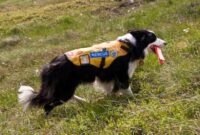Rescue Dog Training – During these sessions we will teach your dog to find interesting and specific scents. This is a great way to mentally stimulate your dog and build their confidence. We also focus on your handling skills to help you bond better with your dogs.
Course £120, 6 sessions and access to FB group for additional feedback, max 4 dogs, 1 hour.
Rescue Dog Training

Flavoring training courses are advertised on our booking website under ‘Option F Courses’. Click here to visit our ordering website. For an appointment, fill out our Search Dogs Pre-Evaluation and Information Form and we will be in touch as soon as possible.
Helping A Rescue Dog Who’s Fearful Of Strangers: Dog Gone Problems
We train your dog to follow a person’s scent. It’s a great activity for any breed or age, and even active dogs can tune out their surroundings and focus on the scent they’re following. Please note that dogs work individually and on long lines during these sessions. While other dogs relax in the car. Don’t worry about someone always staying with the car.
Fill out the Search Dogs Pre-Evaluation and Information Form and we will be in touch as soon as possible. Manta sessions are advertised on our booking website under ‘G Option’ workshops. Click here to visit our ordering website.
Train your dog to find people. We teach your dog to smell the air and find someone hiding and let you know when they find it. You’ll learn scent theory, search techniques, different indicator methods (so your dog can tell you what they’ve found)…and more. This is definitely a very unique and rewarding skill for you and your dog to learn.
Please note that during these sessions dogs are kept separate and on leads while other dogs wait their turn in the car. It is important to note that it is very important that you prepare to hide during these sessions. Not only is it necessary to work with other dogs, but it also ensures that you learn how to properly reward and communicate with your dog at the finder point.
How To Foster A Rescue Dog: Training For You And Training For Your Fos
INTRO £33, Demonstration Theory Introduction, Scent Theory, SAR Dog Training Modules, “Ming”.
Fill out Soekhond’s pre-evaluation and information form and we will be in touch as soon as possible. SAR dog training discussions are posted on our website under ‘G Option’ Workshops. Click here to visit our ordering website.
A special administrative area for professionals (for those planning to become members of SAR professional groups or already members). During SAR training, dogs can learn everything from climbing ladders to safely scaling dangerous piles. Washington Post via Getty Images

It may seem like a dog focused on play would make a poor working dog, but for search and rescue work, this is actually a desirable trait. A dog chasing a tennis ball for hours can find itself through feet of snow, over mountains and along rocky shores until its paws bleed. For this SAR dog, finding the origin of a person’s scent means a game of “find the ball.” This is the basis of SAR training: associating one’s scent with something the dog hates.
Helping An Abused Rescue Dog Get Over His Fear Of Strangers: Dog Gone Problems
A SAR dog’s central task is to detect a person’s scent (“find it”) and effectively alert its handler of its location. SAR training ensures that the dog can perform all tasks regardless of the weather or distractions. Depending on the dog’s specialty, its core training may also include finding a person, returning to the handler, and then regaining the handler’s loyalty to that person or victim. The dog stays with the person and barks to alert the handler.
Most SAR dogs live with and train with a handler, and it takes about 600 hours of training for a dog to be field ready. Sometimes SAR coalitions adopt dogs from shelters, train them for search and rescue, train them in specialized facilities and then match them with handlers. Potential SAR dogs must also be obedient and alert, have a friendly personality (they work closely with strangers and other dogs in search situations) and have a desire to please.
Obedience and awareness are essential. The handler must be able to control the dog at all times and in all situations. But aerial sniffer dogs, which don’t have the advantage of a SAR dog that can’t think for themselves, work outdoors so the handler isn’t always close by to give commands. An ideal search dog can solve problems on its own, but must be aware of its handler at all times.
The general approach to training a dog for search and rescue is different from training a dog to perform other tasks. The first step is to find out what kind of reward your dog gets, and always reward your dog when he does the right thing. During training, handlers associate the reward with each activity the dog wants to do. In the case of SAR dogs, it detects human scent and alerts the handler as quickly as possible. Training begins with very simple tasks and gradually becomes more complex as the dog completes each step.
Is Search And Rescue Dog Training A Good Fit For Your Dog?
Mason Golden Retrievers are trained as avalanche search and rescue dogs. Here she pulls on a rope holding skier Matt Urech while handler Abby Seymour trains in Copper Mountain, Colorado.
Training a dog to “find” is more about leading the dog than teaching it. Dogs have a natural tendency to find scents – SAR training involves telling the dog what scent the handler wants to find and where the scent is. Every time the dog completes a task, it gets a reward. Let’s face it, this particular dog works for a tug of war with smelly socks.
For avalanche training, the first step is simply to look for the dog under the snow. A handler digs a hole in the snow while a second person holds the dog, showing a large scene of the dog running away and jumping into the hole as the dog looks on. When the service dog was released, it ran to find the handler. When he finds a handler, they play tug of war. Interested in finding this dog.

The next step is to increase the holding time of the assistance dog. This increases the amount of memory and attention required to find the handler. First, the assistant holds the dog for five seconds. The dog gets the handler and starts pulling on the leash. The assistant then holds the dog for 10 seconds, then one minute, then five minutes. Every time the dog finds the handler, it is rewarded with a tug.
Rescue Dog Behaviour And Training
Now the handler adds another complication: the helper covers the handle with several inches of snow. This time when the dog runs to find the runner, it cannot see it, but it can smell it. So he started digging. When he found it, he found a smelly sock. Now the dog means that people will be under the snow, and the human smell coming from the snow will reveal the person playing with it. Then the handler and helper switch positions, with the handler handling the dog while the helper hides. By this stage the game is well established and the dog knows what he must do to get his reward.
Finally, derivations are added. The dog starts playing a game of “fetch” with people and dogs lying around and avalanche search equipment like poles and shovels. In a real avalanche search, there are distractions everywhere, and the dog must focus on the search despite the distractions.
Once the dog really gets the hang of the “fetch” game, it should be easy to train the alert to detect it. In an avalanche, dogs usually hide where they detect human scent. If the reward immediately follows the correct warning (meaning the dog digs in the correct place), the dog will continue to warn in this way.
A field-ready SAR dog can focus on the task at hand – whatever its handler is doing – no matter what. This dog maintains vigilance and commitment through all weather conditions and walks treacherous terrain without losing confidence. Training a rescue dog is the fastest way to build a bond that I have found. However, too many volunteers, adopters and even adopters I have spoken to have found walking to be their biggest challenge in working with a rescue dog.
Using Walks And Passive Training To Build Up The Confidence Of This Fearful Rescue Dog: Dog Gone Problems
Training a rescue dog requires patience and persistence, but it does not require much effort or skill
To the rescue dog training, dog rescue training classes, training your rescue dog, rescue training, training an older rescue dog, potty training a rescue dog, training a skittish rescue dog, dog training for rescue dogs, rescue dog in training vest, rescue dog obedience training, training a rescue dog, rescue dog training near me
- Search Rescue Dogs - July 29, 2024
- Police Dog Training - July 25, 2024
- Pointing Dog Training - July 25, 2024




